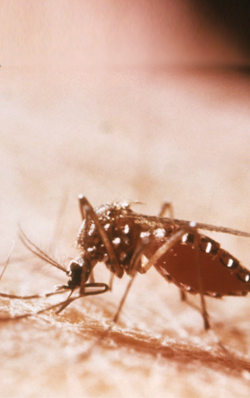
Yellow fever was recognized as a clinical entity as early as in the seventeenth century and was familiar to pirates as the ‘Yellow Jack’. It was a native of Africa and then transported to Europe and America through the trade routes.
Many scientists suggested the role of Aedes egyptii mosquitoes in the incidents of yellow fever. The mosquitoes were found to feed on patients and get infected.
They start to spread the infection from there on. The virus survives in the forest cycle- involving mosquitoes and forest animals.
When the mosquito bites an infected man, the virus reaches the stomach of the mosquito. If the number of virus particles are more, they multiply and starts to infect the epithelial cells of the stomach.
Then the virus invades the circulatory system of the mosquito and finally to the salivary glands. When this mosquito bites a healthy person, it injects the virus along with the saliva into the bloodstream of the bitten individual.
The virus also gets transferred from the mother mosquito to the eggs and then to the larva. Such infected vectors, who had acquired the infection from not a previous blood meal can cause single and sudden outbreaks.
Once reaching a human being, the virus start to reproduce in the lymph nodes and infect the dendritic cells of the neuron. They then head towards the liver and bring about infection of the liver cells.
Kupffer cells are affected indirectly, leading to the degradation of eosinophils present in these cells and ultimately resulting in the release of cytokines. The Councilman bodies start to appear in the liver cells.
Death may result due to the excess amount of cytokines released accompanied with shock and ultimately failure of different organs in the body pursue.
The disease starts off after an incubation period of 3- 6 days with fever, chills, headache, loss of appetite, nausea and vomiting accompanied with blood. The pulse becomes slow but the temperature remains high.
Jaundice, albuminuria, coma and hemorrhagic manifestations develop. The patient may die of hepatic or renal failure. Sensitivity to light, red color in the eyes, face and tongue may build up. Back and knee muscles start to ache.
The liver shows fatty degeneration and necrosis. The necrotised cells unite to form characteristic masses known as Councilman bodies.
The histological condition of the liver is specific enough to be diagnostic, which was the basis of detection of yellow fever in the earlier days.
The disease occurs in two different patterns;
1. In the urban cycle; humans act as the natural reservoir and the definitive host. The virus is transmitted by the bite of domestic Aedes egyptii mosquito.
2. In the forest cycle; wild monkeys act as reservoirs and is transmitted by the bite of forest mosquitoes (Haemagogus spegazzinii). Humans are infected only, when they trespass the forest or when the monkeys invades the villages near the forest.
The only way to control yellow fever is to control the mosquitoes. Vaccination has been considered mandatory to travel to and from endemic areas and is valid for 10 years.





